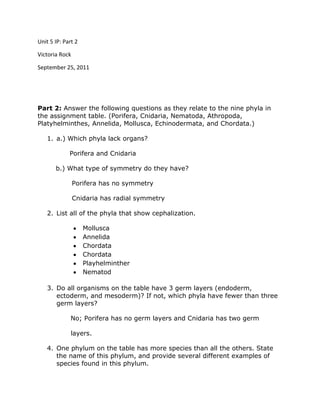
Understanding phyla dichotomous key steps and classification part 2
- 1. Unit 5 IP: Part 2 Victoria Rock September 25, 2011 Part 2: Answer the following questions as they relate to the nine phyla in the assignment table. (Porifera, Cnidaria, Nematoda, Athropoda, Platyhelminthes, Annelida, Mollusca, Echinodermata, and Chordata.) 1. a.) Which phyla lack organs? Porifera and Cnidaria b.) What type of symmetry do they have? Porifera has no symmetry Cnidaria has radial symmetry 2. List all of the phyla that show cephalization. Mollusca Annelida Chordata Chordata Playhelminther Nematod 3. Do all organisms on the table have 3 germ layers (endoderm, ectoderm, and mesoderm)? If not, which phyla have fewer than three germ layers? No; Porifera has no germ layers and Cnidaria has two germ layers. 4. One phylum on the table has more species than all the others. State the name of this phylum, and provide several different examples of species found in this phylum.
- 2. Phylum Arthropoda has the most species which include the crustaceans, arachnids, and insects. Examples include: crabs, shrimps, spiders, butterflies, beetles, and grasshoppers. 5. Fish do not all have the same skeletal structure. Describe the differences among fish from the most primitive to more advanced types of fish. Fish are divided into three classes; Agnatha, Chondrichthyes, and Osteichthyes. Agnatha, referred to as “jawless-fish”, is the most primitive, not only do they lack a jaw, they also have no bone skeleton. Examples of this primitive fish is; the hagfish and lamprey. (Buchheim) Chondrichthyes, referred to as “cartilage-fish”, have a cartilaginous skeleton. Their jaw is also cartilaginous with a loosely attached lower jaw and an array of teeth which they use to attack their prey or defend themselves. Examples of this fish are the shark, rays, and rat-fish. (Buchheim) Osteichthyes, or “boney-fish”, have calcified skeletons. They have great maneuverability and speed, as well as highly specialized mouths equipped with protrusible jaws. This group is the largest of all three groups with 20,000 species ranging from trout, bass, salmon, and perch, just to name a few. (Buchheim) 6. Describe the three types of mammals based on how their young develop. The three types of mammals are the Monotremes, Marsupials, and the Placental. Monotremes, the most primitive, contains only three species’ the duck-billed platypus and tow species of echidna. Although these mammals have hair and produce milk, they lay their eggs, which are similar to a reptile’s egg. After hatching, the baby clings to
- 3. the mothers belly fur and sucks the milk, which comes from pores in the skin instead of nipples. (Animal Bytes: Mammals) Marsupials young grow inside the mother’s body. When born, they climb up the mother’s fur into a pouch on her belly. They continually nourish themselves by latching onto a nipple until they are old enough to come out of the pouch. (Animal Bytes: Mammals) Placental young develop inside the mother’s body, in the uterus which is attached to a placenta giving the growing baby nourishments to develop. Examples of this mammal are; cats, dogs, monkeys, and yes humans. (Animal Bytes: Mammals)
- 4. Reference Audersirk, T. (2011). Chapter 23: Animal Diversity I: Invertebrates . In T. Audersirk, Biology:Life on Earth with Physiology (9th Ed.) (pp. 420-445). San Franciso:Benjamin Cummings. Animal Bytes: Mammals. (n.d.). Retrieved September 24, 2011, from San Diego Zoo: www.sandiegozoo.org/animalbytes/a-mammal.html Buchheim, J. (n.d.). A Quick Course in Ichthyology. Retrieved September 24, 2011, from Odyssey Expeditions: Tropical Marine Biology Voyages: www.marinebiology.org/fish.htm
